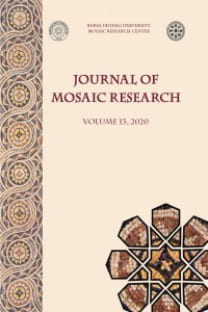Galler - Roma Devri̇’nden Séviac Vi̇llası - Fransa Açık Havada Sergilenen Antik Zemin Mozaiklerinin Değerlendirmesinde, Korunmasında ve Restorasyonunda Çağdaş Yaklaşımlar
Fransa’nın Montréal du Gers Belediyesi’nde bulunan Galler-Roma devrine ait Séviac Villası XIX. yüzyılın sonuna doğru tesadüf eseri keşfedilmiştir. Arkeolojik araştırmalar, IV. yüzyılın sonu ve V. yüzyılın başlangıcının Séviac Villası’nın en parlak dönemi olduğunu ortaya çıkarmıştır. Burası, kesinlikle üst düzey bir aristokrata ait, toplam olarak 25.000 m2’ye yakın bir alanı kapsayan geniş bir köy saray konutuydu. Bu saray konutun, antik dönemlerde toplam olarak yaklaşık 1.500 m2’lik bir alanı kapsayan zemin mozaiklere sahip olduğu düşünülmektedir. Şu anda sit alanı, teknik ve üslup nitelikleri açısından hasar görmemiş yaklaşık 400 m2’lik olağanüstü güzel çok renkli mozaikler ihtiva etmektedir. Kısa bir süre önce, yerel yetkililerin gösterdikleri ilgi sayesinde, bölgenin tarihi, sanatsal ve arkeolojik mirasının korunması ve geliştirmesine yönelik bir dizi program üzerinden bölgeye yatırım yapılması kararlaştırılmıştır. Çalışmaları yürütmek için belli konularda gerekli yeteneklere sahip olduğundan dolayı Portekiz mimar João Luís Carrilho da Graça yönetiminde bir ekip, ihale yoluyla seçilmiştir. Tüm sit alanını eksiksiz bir şekilde kapsayan tamamen işlevsel ve yenilikçi bir örtü sistemi tasarlanıp inşa edilmiştir. Çok karmaşık bir ön teşhis çalışması sonrasında ekip tarafından, RavennAntica Vakfı restorasyon laboratuvarı ile işbirliği içinde, zemin mozaiklerinin tamamının restorasyonu önce tasarlanmış ve ardından yönetilmiştir.
Anahtar Kelimeler:
Séviac, Fransa, geliştirme, restorasyon, mozaikler
The Gallo-Roman Villa of Séviac - France Modern Approaches to the Valorization, Conservation and Restoration of Ancient Floor Mosaics Exposed Outdoors
The Gallo-roman villa of Séviac, located in the Municipality of Montréal du Gers in France, was accidentally discovered at the end of the 19th century. The archaeological investigations identified the end of the 4th and the beginning of the 5th century as the period of its greatest splendour. It was a large rural residence that certainly belonged to a high-ranking aristocrat, covering a total area of about 25,000 sqm. In ancient times, it is believed to have mosaic floors with a total area of approximately 1,500 sqm. Currently, the site boasts about 400 sqm of beautiful polychrome mosaics of undoubted technical and stylistic quality. Recently, thanks to the interest of the local authorities, it was decided to invest in the territory through a series of programs aimed at protecting and enhancing the historical, artistic and archaeological heritage of the territory. Through a public competition, a team headed by the Portuguese architect João Luís Carrilho da Graça was selected, as it possessed the specific skills in the required fields. A new fully functional and innovative system of coverage of the entire site was designed and built. After a very complex preliminary diagnostic work, the team, in cooperation with the restoration laboratory of RavennAntica Foundation, designed and then directed the restoration of the entirety of the mosaic floors.
Keywords:
Séviac, France, enhancement, restoration, mosaics,
___
- Aragon-Launet 1986 P. Aragon-Launet, “Le site gallo-romaine de Séviac a Montrèal-du-Gers”, R. Monturet – H. Riviere (dir.), Les thermes Sud de la villa gallo-romaine de Séviac, Aquitania supplément 2, Paris, 13-18.
- Aragon-Launet 1987 P. Aragon-Launet, “La villa de Séviac à Montréal du Gers”, De l‘âge du fer aux temps barbares, dix ans de recherches archéologiques en Midi-Pyrénées, Toulouse, 76-80.
- Bach – Gaudard 2018 S. Bach – V. Gaudard, “Conserver des vestiges in situ: l‘exemple de la villa gallo-romaine de Séviac”, Monumental, revue scientifique et technique des monuments historiques - semestriel 2, 80-83.
- Balmelle 1976 C. Balmelle, “Le decor végetal des pavements d’Aquitaine”, Mosaïques décors de sols, dossier de l‘Archéologie, n° 15, s.l., 70-75.
- Balmelle 1987 C. Balmelle, Recueil Général des Mosaïques de la Gaule, IV Aquitaine 2, X° supplément à Gallia, Paris.
- Balmelle – Darmon 2017 C. Balmelle – J. P. Darmon, La mosaïque dans les Gaules Romaines, Paris.
- Beaudouin 2011 L. Beaudouin, “La pensée suspendue”, Le visiteur, revue critique d‘architecture n°17, 21-29.
- Fages et al. 2018 B. Fages – D. Darnaude – A. Brunner, “La villa de Séviac: nouvel écrin pour les mosaïques de l‘école d‘Aquitaine”, Archéologia n°566, 50-51.
- Fages – Gugole 2005 B. Fages – J. Gugole, Visiter la villa de Séviac, Luçon.
- Fages – Gugole 2018 B. Fages – J. Gugole, La villa de Séviac, un palais rural aux somptueuses mosaïques, Luçon.
- Gugole 1993 J. Gugole, “Séviac, ou le rêve du palais perdu”, Hommage à Paulette Aragon-Launet, vice-présidente de la société Archéologique du Gers, Auch, 20-29.
- Gugole – Laffitte 1996 J. Gugole – J. B. Laffitte, Mosaïques de Séviac. Le décor de sol d‘une riche villa gallo-romaine du Sud-Ouest, Serres-Castet.
- Perpignani 2019 P. Perpignani, Montréal du Gers, Francia. Sviluppo, ristrutturazione e valorizzazione della villa gallo romana di Séviac. I mosaici pavimentali: studio, progettazione e restauro, thèse de doctorat non publiée, Université de Bologne – Ecole de Lettres et Biens Culturels, Master en Bien Archéologiques, Artistiques et du Paysage: histoire, tutelle et valorisation, session unique année académique.
- Rotbart – Salomon 2011 J. Rotbart – L. Salomon, “La quête du silence”, Le visiteur, revue critique d‘architecture n°17, 8-20.
- ISSN: 1309-047X
- Başlangıç: 2008
- Yayıncı: Ululdağ Üniversitesi, Mozaik Araştırlmaları Merkezi
Sayıdaki Diğer Makaleler
Mozaikte Tamamlama: Uygulama Biçimleri ve Koruma Bakış Açısıyla Değerlendirmeler
Balatlar Kilisesi Mozaiklerinin Koruma - Onarım Uygulamaları
Sedef ÖZTÜRK HETTO, Celalettin KÜÇÜK
Doğu Mozaiklerinde Yarı İnsan Yarı Bitkisel Melezler
Ashdod Maritima, İsrail’de Yeni Keşfedilen Dini Kompleksin Mozaik Zeminlerindeki İnanç Sembolleri
Hierapolis (Pamukkale) Saint Philip Kilisesi Mozaik Harcının Analizi ve Konservasyonu
Bulgaristan’daki Geç Antik Çağ Mozaiklerinde Kozmolojik Temsiller
Geç Roma ve Erken Bizans Dönemleri’nde Tripolis (Lydia) Mozaikleri
Hadrianopolis Kiliseleri Zemin Mozaiklerindeki Haç ve Haçvari Motifler
